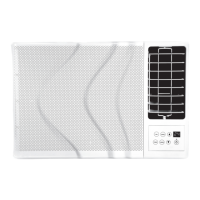PGD4, PGS4, Series G, H WPG4 Series D, H Ultra Low NOx: Installation Instructions
Manufacturer reserves the right to change, at any time, specifications and designs without notice and without obligations.
12
Use a minimum of one hanger every 6 ft (1.8 m). For pipe sizes
larger than 1/2 in., follow recommendations of national codes.
3. Apply joint compound (pipe dope) sparingly and only to male
threads of joint when making pipe connections. Use only pipe dope
that is resistant to action of liquefied petroleum gases as specified
by local and/or national codes. Never use Teflon tape.
4. Install sediment trap in riser leading to heating section (See
Fig. 10). This drip leg functions as a trap for dirt and condensate.
5. Install an accessible, external, manual main shutoff valve in gas
supply pipe within 6 ft (1.8 m) of heating section.
6. Install ground-joint union close to heating section between unit
manual shutoff and external manual main shut-off valve.
7. Pressure test all gas piping in accordance with local and national
plumbing and gas codes before connecting piping to unit.
C99020
Fig. 10 – Sediment Trap
NOTE: Pressure test the gas supply system after the gas supply piping
is connected to the gas valve. The supply piping must be disconnected
from the gas valve during the testing of the piping systems when test
pressure is in excess of 0.5 psig. Pressure test the gas supply piping
system at pressures equal to or less than 0.5 psig. The unit heating
section must be isolated from the gas piping system by closing the
external main manual shutoff valve and slightly opening the
ground-joint union.
8. Check for gas leaks at the field-installed and factory-installed gas
lines after all piping connections have been completed. Use a
commercially available soap solution (or method specified by local
codes and/or regulations).
Step 9 – Install Duct Connections
The unit has duct flanges on the supply- and return-air openings on the
side and bottom of the unit. For downshot applications, the ductwork
connects to the roof curb (See Fig. 3 - Fig. 6 for connection sizes and
locations).
Configuring Units for Downflow (Vertical) Discharge
1. Open all electrical disconnects before starting any service work.
2. Remove horizontal (metal) duct covers to access vertical
(downflow) discharge duct knockouts in unit basepan. (See
Fig. 11.)
3. For single-phase models only, on the discharge side only, remove
the insulation covering the downshot (plastic) knockout. Insulation
is held in place with aluminum tape. Please note that large chassis
units have 2 pieces of insulation, and only the piece over the
downshot knockout needs to be removed. Discard insulation.
4. To remove the downshot (plastic) knockouts for both supply and
returns, break front and right side connecting tabs with a
WARNING
!
FIRE OR EXPLOSION HAZARD
Failure to follow this warning could result in personal injury, death
and/or property damage.
- Connect gas pipe to unit using a backup wrench to avoid
damaging gas controls.
- Never purge a gas line into a combustion chamber. Never test
for gas leaks with an open flame. Use a commercially available
soap solution made specifically for the detection of leaks to
check all connections. A fire or explosion may result causing
property damage, personal injury or loss of life.
- Use proper length of pipe to avoid stress on gas control
manifold.
- If a flexible connector is required or allowed by authority
having jurisdiction, black iron pipe shall be installed at furnace
gas valve and extend a minimum of 2 in. (51 mm) outside
furnace casing.
- If codes allow a flexible connector, always use a new connector.
Do not use a connector which has previously serviced another
gas appliance.
WARNING
!
ELECTRICAL SHOCK HAZARD
Failure to follow this warning could result in personal injury or death.
Before installing or servicing system, always turn off main power to
system and install lockout tag. There may be more than one disconnect
switch.
CAUTION
!
PROPERTY DAMAGE HAZARD
Failure to follow this caution may result in property damage.
Collect ALL screws that were removed. Do not leave screws on rooftop
as permanent damage to the roof may occur.

